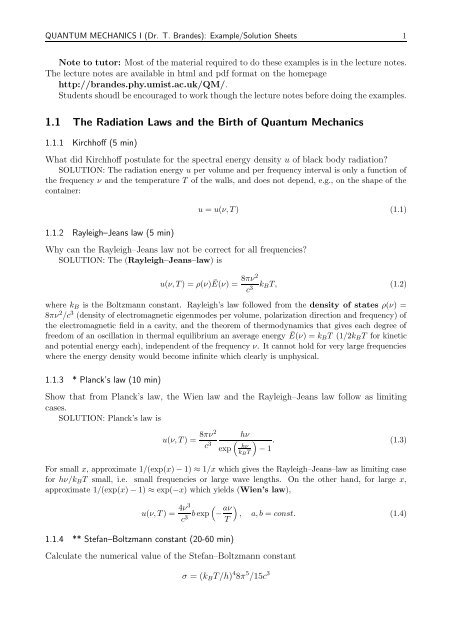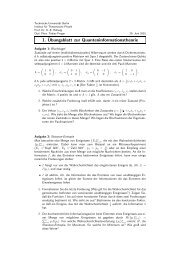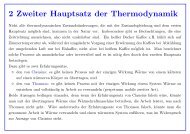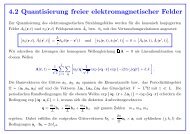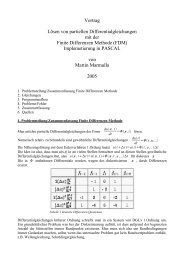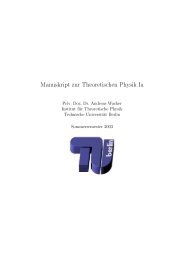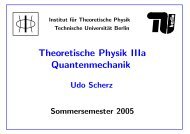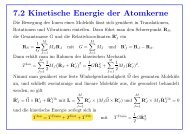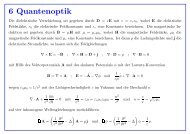1.1 The Radiation Laws and the Birth of Quantum Mechanics
1.1 The Radiation Laws and the Birth of Quantum Mechanics
1.1 The Radiation Laws and the Birth of Quantum Mechanics
Create successful ePaper yourself
Turn your PDF publications into a flip-book with our unique Google optimized e-Paper software.
QUANTUM MECHANICS I (Dr. T. Br<strong>and</strong>es): Example/Solution Sheets 1<br />
Note to tutor: Most <strong>of</strong> <strong>the</strong> material required to do <strong>the</strong>se examples is in <strong>the</strong> lecture notes.<br />
<strong>The</strong> lecture notes are available in html <strong>and</strong> pdf format on <strong>the</strong> homepage<br />
http://br<strong>and</strong>es.phy.umist.ac.uk/QM/.<br />
Students shoudl be encouraged to work though <strong>the</strong> lecture notes before doing <strong>the</strong> examples.<br />
<strong>1.1</strong> <strong>The</strong> <strong>Radiation</strong> <strong>Laws</strong> <strong>and</strong> <strong>the</strong> <strong>Birth</strong> <strong>of</strong> <strong>Quantum</strong> <strong>Mechanics</strong><br />
<strong>1.1</strong>.1 Kirchh<strong>of</strong>f (5 min)<br />
What did Kirchh<strong>of</strong>f postulate for <strong>the</strong> spectral energy density u <strong>of</strong> black body radiation<br />
SOLUTION: <strong>The</strong> radiation energy u per volume <strong>and</strong> per frequency interval is only a function <strong>of</strong><br />
<strong>the</strong> frequency ν <strong>and</strong> <strong>the</strong> temperature T <strong>of</strong> <strong>the</strong> walls, <strong>and</strong> does not depend, e.g., on <strong>the</strong> shape <strong>of</strong> <strong>the</strong><br />
container:<br />
<strong>1.1</strong>.2 Rayleigh–Jeans law (5 min)<br />
u = u(ν, T ) (<strong>1.1</strong>)<br />
Why can <strong>the</strong> Rayleigh–Jeans law not be correct for all frequencies<br />
SOLUTION: <strong>The</strong> (Rayleigh–Jeans–law) is<br />
u(ν, T ) =<br />
ρ(ν)Ē(ν) =<br />
8πν2<br />
c 3 k B T, (1.2)<br />
where k B is <strong>the</strong> Boltzmann constant. Rayleigh’s law followed from <strong>the</strong> density <strong>of</strong> states ρ(ν) =<br />
8πν 2 /c 3 (density <strong>of</strong> electromagnetic eigenmodes per volume, polarization direction <strong>and</strong> frequency) <strong>of</strong><br />
<strong>the</strong> electromagnetic field in a cavity, <strong>and</strong> <strong>the</strong> <strong>the</strong>orem <strong>of</strong> <strong>the</strong>rmodynamics that gives each degree <strong>of</strong><br />
freedom <strong>of</strong> an oscillation in <strong>the</strong>rmal equilibrium an average energy Ē(ν) = k BT (1/2k B T for kinetic<br />
<strong>and</strong> potential energy each), independent <strong>of</strong> <strong>the</strong> frequency ν. It cannot hold for very large frequencies<br />
where <strong>the</strong> energy density would become infinite which clearly is unphysical.<br />
<strong>1.1</strong>.3 * Planck’s law (10 min)<br />
Show that from Planck’s law, <strong>the</strong> Wien law <strong>and</strong> <strong>the</strong> Rayleigh–Jeans law follow as limiting<br />
cases.<br />
SOLUTION: Planck’s law is<br />
u(ν, T ) = 8πν2<br />
c 3<br />
hν<br />
exp<br />
(<br />
hν<br />
k B T<br />
) . (1.3)<br />
− 1<br />
For small x, approximate 1/(exp(x) − 1) ≈ 1/x which gives <strong>the</strong> Rayleigh–Jeans–law as limiting case<br />
for hν/k B T small, i.e. small frequencies or large wave lengths. On <strong>the</strong> o<strong>the</strong>r h<strong>and</strong>, for large x,<br />
approximate 1/(exp(x) − 1) ≈ exp(−x) which yields (Wien’s law),<br />
u(ν, T ) = 4ν3<br />
c 3 b exp (<br />
− aν<br />
T<br />
<strong>1.1</strong>.4 ** Stefan–Boltzmann constant (20-60 min)<br />
Calculate <strong>the</strong> numerical value <strong>of</strong> <strong>the</strong> Stefan–Boltzmann constant<br />
σ = (k B T/h) 4 8π 5 /15c 3<br />
)<br />
, a, b = const. (1.4)
QUANTUM MECHANICS I (Dr. T. Br<strong>and</strong>es): Example/Solution Sheets 2<br />
using <strong>the</strong> Planck radiation law for u(ν, T ). In <strong>the</strong> calculation, you need <strong>the</strong> integral ∫ ∞<br />
dxx 3 /(e x − 1) =<br />
0<br />
π 4 /15 which you should try to prove.<br />
SOLUTION:<br />
Fur<strong>the</strong>rmore,<br />
∫ ∞<br />
0<br />
U(T ) :=<br />
x 3<br />
dx<br />
exp (x) − 1<br />
∫ ∞<br />
0<br />
= 8π(k BT ) 4<br />
h 4 c 3<br />
=<br />
=<br />
dνu(ν, T ) =<br />
∫ ∞<br />
0<br />
∫ ∞<br />
0<br />
∫ ∞<br />
0<br />
dν 8πν2<br />
c 3<br />
x 3<br />
hν<br />
exp<br />
(<br />
hν<br />
k B T<br />
)<br />
− 1<br />
dx<br />
exp (x) − 1 = 8π5 (k B T ) 4<br />
15h 4 c 3 . (1.5)<br />
dx x3 e −x<br />
1 − e −x = ∞ ∑<br />
∞∑<br />
∫<br />
1 ∞<br />
(n + 1) 4<br />
n=0<br />
0<br />
n=0<br />
∫ ∞<br />
0<br />
dxx 3 e −x e nx<br />
dyy 3 e −y = ζ(4)Γ(4) = π4 π4<br />
3! =<br />
90 15 . (1.6)<br />
<strong>The</strong> value <strong>of</strong> <strong>the</strong> Zeta function ζ(4) = ∑ ∞<br />
n=0 1/n4 can be obtained from a Fourier series.<br />
1.2 Waves, particles, <strong>and</strong> wave packets<br />
1.2.1 Macroscopic Object (5 min)<br />
Is <strong>the</strong> de Broglie wave length <strong>of</strong> large, macroscopic objects very small or very large Calculate<br />
<strong>the</strong> de Broglie wave length <strong>of</strong> a 70 kg mass point moving at a constant speed <strong>of</strong> 5 km/h.<br />
Compare it to typical ‘macroscopic’ sizes <strong>of</strong> cars, chairs etc.<br />
SOLUTION: de Broglie wave lengths <strong>of</strong> large, macroscopic objects are very small:<br />
p = h/λ λ =<br />
1.2.2 * Geometrical Optic (2 min)<br />
6.626 · 10 −34 Js<br />
70kg(6000/3600)m/s = 5.7 · 10−36 m. (1.7)<br />
For which limit <strong>of</strong> wave lengths is geometrical optics a limiting case <strong>of</strong> <strong>the</strong> wave <strong>the</strong>ory <strong>of</strong><br />
light<br />
SOLUTION: In <strong>the</strong> limit <strong>of</strong> very small wave lengths, geometrical optics is a limiting case <strong>of</strong> <strong>the</strong><br />
wave <strong>the</strong>ory <strong>of</strong> light.<br />
1.3 Interpretation <strong>of</strong> <strong>the</strong> Wave Function<br />
1.3.1 Schrödinger Equation (5 min)<br />
a) Write down <strong>the</strong> Schrödinger Equation for <strong>the</strong> wave function Ψ(x, t) for a particle with mass<br />
m moving in a potential V (x) in one dimension.<br />
b) Write down <strong>the</strong> Schrödinger Equation for <strong>the</strong> wave function Ψ(x, t) for a particle with<br />
mass m moving in a potential V (x).<br />
SOLUTION: a)<br />
i ∂ [<br />
∂t Ψ(x, t) = − 2 ∂x<br />
2 ]<br />
2m + V (x) Ψ(x, t) (1.8)<br />
b)<br />
i ∂ ∂t Ψ(x, t) = [<br />
− 2 ∆<br />
2m + V (x) ]<br />
Ψ(x, t). (1.9)
QUANTUM MECHANICS I (Dr. T. Br<strong>and</strong>es): Example/Solution Sheets 3<br />
1.3.2 Interpretation <strong>of</strong> <strong>the</strong> Wave Function (2 min)<br />
What is <strong>the</strong> physical meaning <strong>of</strong> <strong>the</strong> wave function <br />
SOLUTION: |Ψ(x, t)| 2 d 3 x is <strong>the</strong> probability for <strong>the</strong> particle to be in <strong>the</strong> (infinitesimal small)<br />
volume d 3 x around x at time t.<br />
1.3.3 Probability (2 min)<br />
What is <strong>the</strong> probability P (Ω) for a particle with wave function Ψ(x, t) to be in a finite volume<br />
Ω <strong>of</strong> space<br />
SOLUTION: <strong>The</strong> probability P (Ω) for <strong>the</strong> particle to be in a finite volume Ω <strong>of</strong> space is given<br />
by <strong>the</strong> integral over this volume:<br />
∫<br />
P (Ω) = d 3 x|Ψ(x, t)| 2 . (<strong>1.1</strong>0)<br />
1.3.4 Probability <strong>and</strong> current density <strong>of</strong> a particle (15 min)<br />
Assume that a particle in an interval [−L/2, L/2] is described by a wave function<br />
Ω<br />
Ψ(x, t) = 1 √<br />
L<br />
e i(kx−ωt) .<br />
What are <strong>the</strong> probability density ρ(x, t) <strong>and</strong> <strong>the</strong> current density j(x, t) for this wave function <br />
How can one express <strong>the</strong> current density by <strong>the</strong> probability density <strong>and</strong> <strong>the</strong> velocity What is<br />
<strong>the</strong> probability to find <strong>the</strong> particle a) anywhere in <strong>the</strong> interval [−L/2, L/2]; b) in <strong>the</strong> interval<br />
[−L/2, 0]; c) in <strong>the</strong> interval [0, L/4] <br />
SOLUTION:<br />
ρ(x, t) := Ψ(x, t)Ψ ∗ (x, t) = 1 L<br />
j(x, t) := − i<br />
2m [Ψ(x, t)∗ ∂ x Ψ(x, t) − Ψ(x, t)∂ x Ψ ∗ (x, t)] = k<br />
mL = p m ρ = vρ,<br />
where v is <strong>the</strong> particle velocity <strong>and</strong> p = k (de Broglie) was used.<br />
<strong>The</strong> probabilities are a) 1; b) 1/2; c) 1/4.<br />
1.4 Fourier Transforms <strong>and</strong> <strong>the</strong> Solution <strong>of</strong> <strong>the</strong> Schrödinger Equation<br />
1.4.1 Definition <strong>of</strong> <strong>the</strong> Fourier Integral (2 min)<br />
Write down <strong>the</strong> decomposition into plane waves <strong>of</strong> a function f(x) <strong>of</strong> one variable x by its<br />
Fourier transform ˜f(k).<br />
SOLUTION: We define <strong>the</strong> decomposition into plane waves <strong>of</strong> a function f(x) <strong>of</strong> one variable x<br />
by its Fourier transform ˜f(k),<br />
∫ ∞<br />
˜f(k) := dxf(x)e −ikx , f(x) = 1 ∫ ∞<br />
dk<br />
2π<br />
˜f(k)e ikx . (<strong>1.1</strong>1)<br />
−∞<br />
−∞<br />
Remarks:<br />
1. In this lecture, we define <strong>the</strong> Fourier transform with <strong>the</strong> factor 1/2π in front <strong>of</strong> f(x). Some people<br />
define it symmetrically, i.e. 1/ √ 2π in front <strong>of</strong> f(x) <strong>and</strong> ˜f(k).<br />
2. Remember <strong>the</strong> Minus signs in <strong>the</strong> exp functions.
QUANTUM MECHANICS I (Dr. T. Br<strong>and</strong>es): Example/Solution Sheets 4<br />
1.4.2 ** Math: Gauß (20 min)<br />
Look up who Gauß was, where he lived etc. Write down <strong>the</strong> definition <strong>of</strong> <strong>the</strong> Gauss function.<br />
Look up examples for areas <strong>of</strong> ma<strong>the</strong>matics <strong>and</strong> physics where <strong>the</strong> Gauss function is used.<br />
SOLUTION: <strong>The</strong> Gauss function is<br />
1 x2<br />
g(x) := √ e− 2σ 2 . (<strong>1.1</strong>2)<br />
2πσ 2<br />
1.4.3 * Math: Gauß Integral 1 (10 min)<br />
Use polar coordinates to calculate ∫ ∞<br />
−y 2<br />
√ −∞ dxdye−x2<br />
πṠOLUTION:<br />
in order to prove <strong>the</strong> above ∫ ∞<br />
−∞ dxe−x2 =<br />
(∫ ∞<br />
) 2<br />
dxe −x2 =<br />
−∞<br />
1.4.4 Math: Gauß Integral 2 (10 min)<br />
∫ ∞<br />
−∞<br />
dxdye −x2 −y 2 = 2π<br />
= [x = r 2 , dx = 2rdr] = π<br />
∫ ∞<br />
0<br />
∫ ∞<br />
Use ∫ ∞<br />
−∞ dxe−x2 = √ π to prove <strong>the</strong> formula for <strong>the</strong> Gauß integral<br />
SOLUTION:<br />
∫ ∞<br />
−∞<br />
∫ ∞<br />
0<br />
drre −r2<br />
dxxe −x = π. (<strong>1.1</strong>3)<br />
dxe −ax2 +bx =<br />
√ π<br />
a eb2 /4a , a > 0. (<strong>1.1</strong>4)<br />
−∞<br />
dxe −ax2 +bx =<br />
= [y = √ a(x − b/2a)] = 1 √ a<br />
∫ ∞<br />
−∞<br />
∫ ∞<br />
−∞<br />
1.4.5 Math: Fourier Transform <strong>of</strong> Gauss Function (20 min)<br />
dxe −a(x−b/2a)2 +b 2 /4a =<br />
dye −y2 +b 2 /4a =<br />
√ π<br />
a eb2 /4a . (<strong>1.1</strong>5)<br />
<strong>The</strong> Gauss function<br />
f(x) :=<br />
1<br />
x2<br />
√ e− 2σ 2 (<strong>1.1</strong>6)<br />
2πσ<br />
2<br />
is a convenient example to discuss properties <strong>of</strong> <strong>the</strong> Fourier transform. Show that it can be<br />
decomposed into plane waves by<br />
˜f(k) =<br />
∫ ∞<br />
−∞<br />
dxf(x)e −ikx = e − 1 2 σ2 k 2 , f(x) = 1<br />
2π<br />
∫ ∞<br />
−∞<br />
dke − 1 2 σ2 k 2 e ikx . (<strong>1.1</strong>7)<br />
Draw f(x) <strong>and</strong> ˜f(k) for different values <strong>of</strong> σ <strong>and</strong> discuss <strong>the</strong>ir relation.<br />
SOLUTION: In principle, one first has to show that <strong>the</strong> formula <strong>1.1</strong>4 for <strong>the</strong> Gauss integral<br />
also holds for complex b. This can be proven by complex integration, but we will not do it here.<br />
<strong>The</strong>n, simple application <strong>of</strong> <strong>1.1</strong>4 with b = −ik yields <strong>the</strong> result for ˜f(k). <strong>The</strong> equation for f(x)<br />
<strong>the</strong>n is simply <strong>the</strong> Fourier back–transformation (definition), but you can explicitely verify it again<br />
by calculating <strong>the</strong> Gauss integral.<br />
Small σ: corresponds to a narrow Gauss function f(x) in x–space <strong>and</strong> a broad distribution ˜f(k) <strong>of</strong><br />
Fourier components in k–space.<br />
Large σ: corresponds to a broad Gauss function f(x) in x–space <strong>and</strong> a narrow distribution ˜f(k) <strong>of</strong><br />
Fourier components in k–space.
QUANTUM MECHANICS I (Dr. T. Br<strong>and</strong>es): Example/Solution Sheets 5<br />
1.4.6 * Wave packet (20 min)<br />
We assume that a particle with energy E = p 2 /2m can be described by a function that is a<br />
superposition <strong>of</strong> plane waves,<br />
Ψ(x, t) =<br />
∫ ∞<br />
−∞<br />
dka(k)e i(kx−ω(k)t) , ω(k) = E = 2 k 2 /(2m). (<strong>1.1</strong>8)<br />
Use<br />
a(k) = C √ σ 2 /(2π)e −k2 σ 2 /2<br />
to calculate <strong>the</strong> wave packet Ψ(x, t). Here, C is a constant. Show that<br />
)<br />
C<br />
Ψ(x, t) = √<br />
(−<br />
1 + i(t/mσ2 ) exp x 2<br />
.<br />
2σ 2 [1 + i(t/mσ 2 )]<br />
To simplify your calculation, you can set = 2m = 1 during your calculation <strong>and</strong> re-install it<br />
in <strong>the</strong> result. Why does this ‘trick’ work Discuss Ψ(x, t) as a function <strong>of</strong> time.<br />
SOLUTION: <strong>The</strong> solution <strong>of</strong> this problem is discussed in many text books. Basically, one has to<br />
calculate a Gauss integral <strong>of</strong> <strong>the</strong> type <strong>1.1</strong>4. As a function <strong>of</strong> time, Ψ(x, t) becomes broader. Actually,<br />
<strong>the</strong> physical interesting quantity is <strong>the</strong> square |Ψ(x, t)| 2 which is <strong>the</strong> probability density to find <strong>the</strong><br />
particle in <strong>the</strong> interval [x, x + dx] at time t. We see from this calculation that this probability density<br />
becomes broader with increasing time: If <strong>the</strong> particle was initially localized near <strong>the</strong> origin x = 0,<br />
it ‘spreads’ out. However, this does not mean that <strong>the</strong> particle disintegrates into smaller pieces or<br />
even into a continuous mass distribution. |Ψ(x, t)| 2 is not a mass density but a probability density:<br />
if we ‘look’ at time t if <strong>the</strong> particle is in <strong>the</strong> interval [x, x + dx], it is ei<strong>the</strong>r <strong>the</strong>re (with probability<br />
|Ψ(x, t)| 2 dx) or not.<br />
1.5 Position <strong>and</strong> Momentum in <strong>Quantum</strong> <strong>Mechanics</strong><br />
1.5.1 Normalization (2min)<br />
Write down <strong>the</strong> normalization condition for <strong>the</strong> wave function Ψ(x, t) <strong>of</strong> a particle that is<br />
necessary to interpret |Ψ(x, t)| 2 as a probability density.<br />
SOLUTION: <strong>The</strong> probability to find <strong>the</strong> particle somewhere in space must be one <strong>and</strong> hence<br />
∫<br />
R 3 d 3 x|Ψ(x, t)| 2 = 1. (<strong>1.1</strong>9)<br />
1.5.2 Expectation values in quantum mechanics (5min)<br />
Write down <strong>the</strong> expectation value <strong>of</strong> <strong>the</strong> position x <strong>and</strong> <strong>the</strong> momentum p <strong>of</strong> a particle with a<br />
normalized wave function Ψ(x, t).<br />
SOLUTION:<br />
∫<br />
〈x〉 t =<br />
∫<br />
dxΨ ∗ (x, t)xΨ(x, t), 〈p〉 t =<br />
dxΨ ∗ (x, t) ∂ x<br />
Ψ(x, t) (1.20)<br />
i<br />
We recognize that <strong>the</strong> position x corresponds to <strong>the</strong> operator ‘multiplication with x’. On <strong>the</strong> o<strong>the</strong>r<br />
h<strong>and</strong>, <strong>the</strong> momentum corresponds to <strong>the</strong> operator −i∂ x .
QUANTUM MECHANICS I (Dr. T. Br<strong>and</strong>es): Example/Solution Sheets 6<br />
1.5.3 Wave packet (10-30 min)<br />
We consider <strong>the</strong> wave function (wave packet)<br />
Ψ(x) =<br />
1<br />
√√ exp<br />
πa<br />
2<br />
(− x2<br />
2a 2 )<br />
. (1.21)<br />
1. Show that this wave function is normalized (remember what normalization means!)<br />
2. Using this wave function, calculate <strong>the</strong> expectation values 〈x 2 〉, 〈p 2 〉, <strong>and</strong> <strong>the</strong>ir product<br />
〈x 2 〉 · 〈p 2 〉. You have to use <strong>the</strong> integral ∫ ∞<br />
−∞ dyy2 e −a2 y 2 = √ π/(2a 3 ).<br />
SOLUTION:<br />
〈p 2 〉 =<br />
〈x 2 〉 =<br />
∫ ∞<br />
−∞<br />
= − 2<br />
a √ π<br />
= − 2<br />
a √ π<br />
ψ(x) (− 2 ) ∂2<br />
2<br />
ψ(x) dx = −<br />
∂x2 a √ π<br />
∫ ∞<br />
−∞<br />
∫ ∞<br />
−∞<br />
= − 2 ( √ π<br />
a √ −<br />
π a<br />
∫ ∞<br />
−∞<br />
= a3<br />
a √ π<br />
e −x2 /(2a 2 )<br />
∫ ∞<br />
−∞<br />
∂<br />
(<br />
− x ) /(2a 2 )<br />
∂x a 2 e−x2 dx<br />
(− 1 a 2 + x2<br />
a 4 )<br />
e −x2 /(a 2) dx<br />
√ π<br />
) + = − 2<br />
2a a √ π<br />
ψ(x) x 2 ψ(x) dx = 1<br />
a √ π<br />
∫ ∞<br />
−∞<br />
1.5.4 * Hamilton function (10min)<br />
∫ ∞<br />
−∞<br />
(<br />
−<br />
e −x2 /(2a 2 ) ∂ 2<br />
√ π<br />
)<br />
= 2<br />
2a 2a 2<br />
x 2 e −x2 /(a 2) dx<br />
∂x 2 e−x2 /(2a 2) dx<br />
u 2 e −u2 du = a2<br />
√ π<br />
√ π<br />
2 = a2<br />
2 . (1.22)<br />
Write down <strong>the</strong> Hamilton function <strong>of</strong> a classical particle moving in a one dimensional potential<br />
V (x). Write down <strong>the</strong> corresponding quantum mechanical Hamilton operator (‘Hamiltonian’).<br />
Write down <strong>the</strong> Schrödinger equation in ‘abstract form’, using <strong>the</strong> Hamilton operator.<br />
SOLUTION: <strong>The</strong> total energy in classical mechanics for a conservative system <strong>of</strong> a particle <strong>of</strong><br />
mass m in a potential V (x) (energy is conserved) is given by a Hamilton function<br />
H(p, x) = p2<br />
+ V (x). (1.23)<br />
2m<br />
<strong>The</strong> correspondence principle from axiom 2 tells us that this Hamilton function in quantum<br />
mechanics has to be replaced by a Hamilton operator (Hamiltonian) Ĥ<br />
Ĥ = − 2 ∆<br />
+ V (ˆx). (1.24)<br />
2m<br />
Here, we have used <strong>the</strong> definition <strong>of</strong> <strong>the</strong> Laplace operator ∆ = ∇ · ∇. In Cartesian coordinates, it<br />
is ∆ = ∂x 2 + ∂2 y + ∂2 z . <strong>The</strong> Hamilton operator represents <strong>the</strong> total energy <strong>of</strong> <strong>the</strong> particle with mass<br />
m in <strong>the</strong> potential V (x). We have introduced <strong>the</strong> hat as a notation for operators, but <strong>of</strong>ten <strong>the</strong> hat<br />
is omitted for simplicity. We make <strong>the</strong> important observation that Ĥ is exactly <strong>the</strong> expression that<br />
appears on <strong>the</strong> right h<strong>and</strong> side <strong>of</strong> <strong>the</strong> Schrödinger equation. This means we can write <strong>the</strong> Schrödinger<br />
equation as<br />
i ∂ Ψ(x, t) = ĤΨ(x, t). (1.25)<br />
∂t
QUANTUM MECHANICS I (Dr. T. Br<strong>and</strong>es): Example/Solution Sheets 7<br />
1.5.5 * Commutator 1 (10 min)<br />
Prove <strong>the</strong> commutator relation in one dimension, [ˆx, ˆp] := i, where [A, B] := AB − BA.<br />
SOLUTION: Position x <strong>and</strong> momentum p are operators in quantum mechanics. Acting on wave<br />
functions, <strong>the</strong> operator product xp has <strong>the</strong> property<br />
ˆxˆpΨ(x) = i x ∂<br />
∂x Ψ(x) = i xΨ′ (x)<br />
ˆpˆxΨ(x) = ∂<br />
i ∂x xΨ(x) = (<br />
Ψ(x) + xΨ ′ (x) ) (1.26)<br />
i<br />
<strong>The</strong> result depends on <strong>the</strong> order <strong>of</strong> ˆx <strong>and</strong> ˆp: both operators do not commute. One has<br />
Comparing both sides, we have <strong>the</strong> commutation relation<br />
(ˆxˆp − ˆpˆx)Ψ(x) = iΨ(x) (1.27)<br />
[ˆx, ˆp] := ˆxˆp − ˆpˆx = i. (1.28)<br />
2.6 <strong>The</strong> stationary Schrödinger Equation<br />
2.6.1 Definitions (2min)<br />
Write down <strong>the</strong> stationary Schrödinger equation in one <strong>and</strong> three dimensions for a particle <strong>of</strong><br />
mass m in a potential V (x).<br />
SOLUTION: <strong>The</strong> stationary Schrödinger equation is<br />
[<br />
]<br />
Ĥψ(x) = Eψ(x) ←→ − 2 ∆<br />
2m + V (x) ψ(x) = Eψ(x) (2.29)<br />
in three dimensions, in one dimensions x instead <strong>of</strong> x <strong>and</strong> ∂x 2 instead <strong>of</strong> ∆. Ma<strong>the</strong>matically, <strong>the</strong><br />
equation Ĥψ = Eψ with <strong>the</strong> operator Ĥ is an eigen value equation. We know eigenvalue equations<br />
from linear algebra where Ĥ is a matrix <strong>and</strong> ψ is a vector. <strong>The</strong> wave function has been separated<br />
according to (see lecture notes)<br />
2.6.2 Piecewise constant potentials in one dimension (5min)<br />
Write down <strong>the</strong> general solution <strong>of</strong><br />
[− 2<br />
Ψ(x, t) = ψ(x)e −iEt/ . (2.30)<br />
]<br />
d 2<br />
2m dx + V ψ(x) = Eψ(x), x ∈ [x 2 1 , x 2 ] (2.31)<br />
for E < V <strong>and</strong> E > V . What is <strong>the</strong> difference between <strong>the</strong>se two cases<br />
SOLUTION: This is a second order ordinary differential equation with constant coefficients.<br />
<strong>The</strong>re are two independent solutions<br />
√<br />
2m<br />
ψ + (x) = e ikx , ψ − (x) = e −ikx , k := (E − V ). (2.32)<br />
2 1. If E > V , <strong>the</strong> wave vector k is a real quantity <strong>and</strong> <strong>the</strong> two solutions ψ ± (x) are plane waves<br />
running in <strong>the</strong> positive <strong>and</strong> <strong>the</strong> negative x–direction. Such solutions are called oscillatory solutions.
QUANTUM MECHANICS I (Dr. T. Br<strong>and</strong>es): Example/Solution Sheets 8<br />
2. If E < V , k becomes imaginary <strong>and</strong> we write<br />
√<br />
2m<br />
k = iκ := i (V − E) (2.33)<br />
2 with <strong>the</strong> real quantity κ. <strong>The</strong> two independent solutions <strong>the</strong>n become exponential functions e ±κx .<br />
Such solutions are called exponential solutions.<br />
For fixed energy E, <strong>the</strong> general solution ψ(x) will be a superposition, that is a linear combination<br />
ψ(x) = ae ikx + be −ikx (2.34)<br />
with k ei<strong>the</strong>r real or imaginary, k = iκ. Since <strong>the</strong> wave function in general is a complex function,<br />
<strong>the</strong> coefficients a, b can be complex numbers. Note that we can not have linear combinations with<br />
one real <strong>and</strong> one imaginary term in <strong>the</strong> exponential like ae ikx + be −κx , a, b ≠ 0.<br />
2.7 <strong>The</strong> Infinite Potential Well<br />
2.7.1 Energies <strong>and</strong> Eigenstates I (10-20 min)<br />
Consider <strong>the</strong> motion <strong>of</strong> a particle <strong>of</strong> mass m within <strong>the</strong> interval [x 1 , x 2 ] = [0, L], L > 0 between<br />
<strong>the</strong> infinitely high walls <strong>of</strong> <strong>the</strong> potential<br />
⎧<br />
⎨ ∞, −∞ < x ≤ 0<br />
V (x) = 0, 0 < x ≤ L<br />
(2.35)<br />
⎩<br />
∞ L < x < ∞<br />
Show that <strong>the</strong> normalized energy eigenstate wave functions <strong>and</strong> energies are<br />
√<br />
2<br />
( nπx<br />
)<br />
ψ n (x) =<br />
L sin , E = E n = n2 2 π 2<br />
, n = 1, 2, 3, ... (2.36)<br />
L<br />
2mL2 SOLUTION: (see lecture notes) Outside <strong>the</strong> interval [0, L] <strong>the</strong> particle can not exist <strong>and</strong> its wave<br />
function must be zero, i.e.<br />
⎧<br />
⎨ 0, −∞ < x ≤ 0<br />
ψ(x) = ae ikx + be −ikx , 0 < x ≤ L<br />
(2.37)<br />
⎩<br />
0, L < x < ∞<br />
We dem<strong>and</strong> that <strong>the</strong> wave function vanishes at x = 0 <strong>and</strong> x = L so that it is continuous a <strong>the</strong>se<br />
points. Clearly, this makes physically sense because at x = 0, L <strong>the</strong> potential is infinitely high <strong>and</strong><br />
<strong>the</strong> probability density |ψ(x)| 2 to find <strong>the</strong> particle <strong>the</strong>re should be zero. We obtain<br />
ψ(0) = 0 0 = a + b ψ(x) = c sin(kx), 0 ≤ x ≤ L, c = const.<br />
ψ(L) = 0 sin(kL) = 0. (2.38)<br />
<strong>The</strong> first condition tells us that <strong>the</strong> wave function must be a sine–function. <strong>The</strong> second condition is<br />
more interesting: it sets a condition for <strong>the</strong> possible values k n that k can have,<br />
kL = nπ k ≡ k n = nπ , n = 1, 2, 3, ... (2.39)<br />
L<br />
<strong>The</strong> second boundary condition at x = L restricts <strong>the</strong> possible values <strong>of</strong> <strong>the</strong> energy E, because<br />
k := √ (2m/ 2 ) (E − V ) = √ (2m/ 2 )E. <strong>The</strong>refore, <strong>the</strong> energy can only acquire values<br />
E n = 2 kn<br />
2<br />
2m = n2 2 π 2<br />
, n = 1, 2, 3, ... (2.40)<br />
2mL2
QUANTUM MECHANICS I (Dr. T. Br<strong>and</strong>es): Example/Solution Sheets 9<br />
In order to interpret <strong>the</strong> absolute square wave <strong>of</strong> <strong>the</strong> wave functions φ n (x) = c sin(k n x) as a probability<br />
density, we have to dem<strong>and</strong><br />
1 =<br />
= 1 2<br />
∫ L<br />
0<br />
∫ L<br />
0<br />
dx|ψ n (x)| 2 =<br />
∫ L<br />
0<br />
dx|c| 2 sin 2 (nπx/L)<br />
dx|c| 2 [1 − cos(n2πx/L)] = |c|2 L<br />
2<br />
|x| 2 = 2 L c = √<br />
2<br />
L eiφ ψ n (x) =<br />
√<br />
2<br />
L sin(nπx/L)eiϕ , (2.41)<br />
where ϕ ∈ R is a (real) phase factor. This normalization condition determines <strong>the</strong> wave functions<br />
ψ n (x) uniquely only up to a phase factor.<br />
2.7.2 Energies <strong>and</strong> Eigenstates II (10-20 min)<br />
Consider <strong>the</strong> motion <strong>of</strong> a particle <strong>of</strong> mass m within <strong>the</strong> infinitely high potential well<br />
⎧<br />
⎨ ∞, −∞ < x ≤ −L/2<br />
V (x) = 0, −L/2 < x ≤ L/2<br />
⎩<br />
∞ L/2 < x < ∞<br />
(2.42)<br />
Determine <strong>the</strong> eigenfunctions ψ n (x) <strong>and</strong> energy eigenvalues E n explicitly. What are <strong>the</strong> symmetry<br />
properties <strong>of</strong> <strong>the</strong> eigenfunctions Can you recover <strong>the</strong>m from <strong>the</strong> solutions <strong>of</strong> <strong>the</strong> infinite<br />
well on <strong>the</strong> interval [0, L] (see above <strong>and</strong> lecture notes)<br />
SOLUTION: We write <strong>the</strong> general wave function as<br />
⎧<br />
⎨ 0, −∞ < x ≤ −L/2<br />
ψ(x) = a ′ e ikx + b ′ e −ikx , −L/2 < x ≤ L/2<br />
(2.43)<br />
⎩<br />
0, L/2 < x < ∞<br />
To make our life easier, we write this by re–defining <strong>the</strong> coefficients a ′ <strong>and</strong> b ′ as<br />
ψ(x) = ae ik(x−L/2) + be −ik(x−L/2) , −L/2 < x ≤ L/2. (2.44)<br />
From ψ(L/2) = 0 we immediately obtain a + b = 0 which is fine because it tells us ψ(x) ∝ sin k(x −<br />
L/2). From ψ(−L/2) = 0 we immediately obtain sin kL = 0 whence kL = nπ, n = 1, 2, 3, 4, ... (n = 0<br />
is <strong>the</strong> zero solution, n = −1, −2, .. give nothing new. <strong>The</strong> possible energies <strong>the</strong>refore are<br />
We thus have (within <strong>the</strong> well)<br />
E n = 2 kn<br />
2<br />
2m = n2 2 π 2<br />
, n = 1, 2, 3, ... (2.45)<br />
2mL2 ψ(x) ∝ sin(kx − nπ/2) ∝<br />
{ sin kx, n = 2, 4, 6, ... even<br />
cos kx, n = 1, 3, 5, ... odd<br />
(2.46)<br />
Writing ∝ is a convenient way to avoid too much notation until <strong>the</strong> point were we eventually have<br />
to become clear about <strong>the</strong> normalization: Within <strong>the</strong> well,<br />
⎧ √<br />
⎨ 2<br />
ψ(x) = √<br />
L<br />
sin kx, n = 2, 4, 6, ... odd function<br />
(2.47)<br />
⎩ 2<br />
L cos kx, n = 1, 3, 5, ... even function
QUANTUM MECHANICS I (Dr. T. Br<strong>and</strong>es): Example/Solution Sheets 10<br />
2.7.3 * Orthonormality (10 min)<br />
Consider <strong>the</strong> Hilbert space H <strong>of</strong> wave functions ψ(x) <strong>of</strong> <strong>the</strong> infinite potential well on <strong>the</strong><br />
interval [0, L] with ψ(0) = ψ(L) = 0. Show that <strong>the</strong> basis vectors<br />
√<br />
2<br />
( nπx<br />
)<br />
ψ n (x) =<br />
L sin L<br />
form an orthonormal system.<br />
SOLUTION: We have to show that <strong>the</strong> ψ n (x) form an orthonormal basis:<br />
0<br />
∫ L<br />
0<br />
dxψ ∗ n(x)ψ m (x) = δ nm . (2.48)<br />
We <strong>the</strong>refore have to calculate <strong>the</strong> integral<br />
∫ √ L 2<br />
( nπx<br />
) √<br />
dx<br />
L sin 2<br />
( mπx<br />
)<br />
L L sin . (2.49)<br />
L<br />
For n = m we have already calculated this integral above when we obtained <strong>the</strong> normalization <strong>of</strong><br />
<strong>the</strong> wave functions. For n ≠ m we have to show that 2.49 is zero: Do this by exp<strong>and</strong>ing <strong>the</strong> sin into<br />
exponentials <strong>and</strong> calculating <strong>the</strong> integrals, or use a <strong>the</strong>orem for trigonometric functions, or look it<br />
up in a table.<br />
2.7.4 Time Evolution (2 min)<br />
Consider a wave function ψ(x) <strong>of</strong> <strong>the</strong> infinite potential well on <strong>the</strong> interval [0, L]. Consider<br />
<strong>the</strong> case when <strong>the</strong> wave function at time t = 0 is one <strong>of</strong> <strong>the</strong> eigenstates <strong>of</strong> energy E n , i.e.<br />
Ψ(x, t = 0) = ψ n (x) <strong>and</strong> check that <strong>the</strong> time evolution <strong>of</strong> a wave function that is an energy<br />
eigenstate is just given by multiplication with <strong>the</strong> time–dependent phase factor e −iEnt/ , that<br />
is<br />
Ψ(x, t = 0) = ψ n (x) Ψ(x, t) = ψ n (x)e −iEnt/ . (2.50)<br />
SOLUTION: In principle, this is in general already clear from <strong>the</strong> definition <strong>of</strong> <strong>the</strong> stationary<br />
states (see lecture notes): To solve<br />
we had made a separation ansatz<br />
Inserting into <strong>the</strong> Schrödinger equation, we have<br />
i ∂ Ψ(x, t) = ĤΨ(x, t), (2.51)<br />
∂t<br />
Ψ(x, t) = ψ(x)f(t). (2.52)<br />
i∂ t f(t)<br />
f(t)<br />
= Ĥψ(x)<br />
ψ(x)<br />
= E, (2.53)<br />
where we have separated <strong>the</strong> t– <strong>and</strong> <strong>the</strong> x–dependence. Both sides <strong>of</strong> depend on t resp. x independently<br />
<strong>and</strong> <strong>the</strong>refore must be constant = E. Solving <strong>the</strong> equation for f(t) yields f(t) = exp −iEt/<br />
<strong>and</strong> <strong>the</strong>refore<br />
Ψ(x, t) = ψ(x)e −iEt/ . (2.54)<br />
We recognize: <strong>the</strong> time evolution <strong>of</strong> <strong>the</strong> wave function Ψ(x, t) is solely determined by <strong>the</strong> factor<br />
exp −iEt/. Fur<strong>the</strong>rmore, <strong>the</strong> constant E must be an energy (dimension!).<br />
We can also check directly that Ψ(x, t) fulfills <strong>the</strong> time–dependent Schrödinger equation:<br />
Ĥψ n (x) = E n ψ n (x) i ∂ ∂t Ψ(x, t) = i ∂ ∂t ψ n(x)e −iEnt/ = E n ψ n (x)e −iEnt/<br />
= Ĥψ n(x)e −iEnt/ = ĤΨ(x, t). (2.55)
QUANTUM MECHANICS I (Dr. T. Br<strong>and</strong>es): Example/Solution Sheets 11<br />
2.7.5 Expectation values (15 min)<br />
Calculate <strong>the</strong> expectation value <strong>of</strong> a) <strong>the</strong> momentum square p 2 <strong>and</strong> b) <strong>the</strong> kinetic energy<br />
<strong>of</strong> a particle in <strong>the</strong> one–dimensional infinite well on <strong>the</strong> interval [0, L] with wave function<br />
Ψ(x, t) = ψ n (x)e −iEnt/ .<br />
SOLUTION: Use ∂x 2ψ n(x) = −(n 2 2 /L 2 )ψ n (x):<br />
〈p 2 〉 t =<br />
∫ L<br />
0<br />
dxψ n (x) 2 ∂ 2 x<br />
i 2<br />
ψ n (x) = − 2 ∫ L<br />
0<br />
dxψ n (x)<br />
(− n2 π 2 )<br />
L 2 ψ n (x)<br />
= n2 2 π 2<br />
L 2 〈 p2<br />
2m 〉 t = n2 2 π 2<br />
2L 2 m 2 = E n. (2.56)<br />
This is a very obvious result: since <strong>the</strong> energy <strong>of</strong> <strong>the</strong> wave function ψ n (x) is E n , <strong>the</strong> expectation<br />
value <strong>of</strong> <strong>the</strong> kinetic energy E = p 2 /2m (= <strong>the</strong> total energy), i.e. <strong>the</strong> value one obtains on averaging<br />
<strong>the</strong> results from many measurements on <strong>the</strong> same system with <strong>the</strong> same wave function, must be E n .<br />
We can obtain this result even easier by calculating <strong>the</strong> expectation value <strong>of</strong> <strong>the</strong> energy<br />
〈Ĥ〉 t =<br />
∫ L<br />
0<br />
dxψ n (x)Hψ n (x) =<br />
∫ L<br />
0<br />
dxψ n (x)E n ψ n (x) = E n , (2.57)<br />
where we have used <strong>the</strong> Schrödinger equation Ĥψ n = E n ψ n <strong>and</strong> <strong>the</strong> orthonormality <strong>of</strong> <strong>the</strong> ψ n .<br />
2.7.6 * Time evolution <strong>of</strong> superposition (10 min)<br />
a) What is <strong>the</strong> time evolution <strong>of</strong> an arbitrary wave function Ψ(x, t = 0),<br />
∞∑<br />
∫ L<br />
Ψ(x, t = 0) = c n ψ n (x), c n = dxψn ∗ (x)Ψ(x) (2.58)<br />
b) Consider <strong>the</strong> wave function<br />
n=0<br />
0<br />
Ψ(x, t = 0) = 1 √<br />
2<br />
(ψ 1 (x) + ψ 2 (x)) . (2.59)<br />
What is <strong>the</strong> probability density to find <strong>the</strong> particle at x at time t<br />
SOLUTION:<br />
a) <strong>The</strong> Schrödinger equation is a linear partial differential equation, so <strong>the</strong> answer is simple: it is<br />
just given by <strong>the</strong> superposition<br />
∞∑<br />
Ψ(x, t) = c n ψ n (x)e −iEnt/ (2.60)<br />
n=0<br />
i∂ t Ψ(x, t) =<br />
=<br />
∞∑<br />
c n E n ψ n (x)e −iEnt/<br />
n=0<br />
∞∑<br />
c n Ĥψ n (x)e −iEnt/<br />
n=0<br />
where we used <strong>the</strong> fact that Ĥ is a linear operator.<br />
b) <strong>The</strong> time evolution is obtained as<br />
= Ĥ<br />
∞∑<br />
c n ψ n (x)e −iEnt/<br />
n=0<br />
= ĤΨ(x, t),<br />
Ψ(x, t) = 1 √<br />
2<br />
(ψ 1 (x)e −iE 1t/ + ψ 2 (x)e −iE 2t/ ) . (2.61)<br />
From this we obtain <strong>the</strong> probability density<br />
|Ψ(x, t)| 2 = 1 (<br />
ψ<br />
2<br />
2 1 (x) + ψ2 2 (x) + 2ψ 1(x)ψ 2 (x) cos[(E 1 − E 2 )t/] ) , (2.62)<br />
which is no longer constant as a function <strong>of</strong> time.
QUANTUM MECHANICS I (Dr. T. Br<strong>and</strong>es): Example/Solution Sheets 12<br />
2.8 <strong>The</strong> Finite Potential Well<br />
2.8.1 Parity (10 min)<br />
Show that <strong>the</strong> solutions <strong>of</strong> <strong>the</strong> stationary Schrödinger equation with <strong>the</strong> one–dimensional<br />
potential<br />
⎧<br />
⎨ 0, −∞ < x ≤ −a<br />
V (x) = −V < 0, −a < x ≤ a<br />
(2.63)<br />
⎩<br />
0 a < x < ∞<br />
can be chosen as even <strong>and</strong> odd solutions.<br />
SOLUTION: (see lecture notes) For symmetric potentials V (x) = V (−x), <strong>the</strong> Schrödinger<br />
equation has an important property: If ψ(x) is a solution <strong>of</strong> Ĥψ(x) = Eψ(x), <strong>the</strong>n also ψ(−x) is<br />
a solution with <strong>the</strong> same E, i.e. Ĥψ(−x) = Eψ(−x) (replace −x → x <strong>and</strong> note that ∂x 2 = ∂2 −x .<br />
Since Ĥ is linear, also linear combinations <strong>of</strong> solutions with <strong>the</strong> same eigenvalue E are solutions with<br />
eigenvalue E, in particular <strong>the</strong> symmetric (even) <strong>and</strong> anti symmetric (odd) linear combinations<br />
ψ e (x) := 1 √<br />
2<br />
[ψ(x) + ψ(−x)], ψ o (x) := 1 √<br />
2<br />
[ψ(x) − ψ(−x)]. (2.64)<br />
<strong>The</strong>se are <strong>the</strong> solutions with even (e) <strong>and</strong> odd (o) parity, respectively.<br />
2.8.2 Wave functions (5 min)<br />
Draw <strong>the</strong> wave functions for energy E < 0 corresponding to <strong>the</strong> potential V (x), (2.63). What<br />
about energies E < −V <br />
SOLUTION: <strong>The</strong>re are no solutions for E < −V .<br />
2.9 Scattering states in one dimension<br />
2.9.1 Plane Waves (5 min)<br />
Show that plane waves solve <strong>the</strong> one–dimensional stationary Schrödinger equation for zero<br />
potential. Derive <strong>the</strong> dispersion relation E = E(k), where E is <strong>the</strong> energy <strong>and</strong> k <strong>the</strong> wave<br />
vector. Show that plane waves can not be normalized over <strong>the</strong> whole x–axis.<br />
SOLUTION: We check this by inserting into <strong>the</strong> Schrödinger equation:<br />
− 2 ∂ 2 x<br />
2m ψ k(x) = Eψ k (x), ψ k (x) = e ikx<br />
E = E(k) = 2 k 2<br />
2m . (2.65)<br />
A problem arises, because ψ k (x) can not be normalized over <strong>the</strong> whole x–axis according to<br />
∫ ∞<br />
−∞<br />
dx|ψ k (x)| 2 = 1, (2.66)<br />
because this integral is infinite. A practical solution is to consider a large, but finite interval<br />
[−L/2, L/2] instead <strong>of</strong> <strong>the</strong> total x–axis, <strong>and</strong> to normalize <strong>the</strong> wave functions according to<br />
ψ k = 1 √<br />
L<br />
e ikx ,<br />
∫ L/2<br />
−L/2<br />
dx|ψ k (x)| 2 = 1. (2.67)<br />
See lecture notes for a fur<strong>the</strong>r discussion.
QUANTUM MECHANICS I (Dr. T. Br<strong>and</strong>es): Example/Solution Sheets 13<br />
2.9.2 Piecewise constant potential (25 min)<br />
We consider a 1d piecewise constant potential <strong>and</strong> a stationary wave function at energy E.<br />
⎧<br />
⎧<br />
V 1 ,<br />
a 1 e ik1x + b 1 e −ik1x , −∞ < x ≤ x 1<br />
V 2 ,<br />
a 2 e ⎪⎨<br />
⎪⎨<br />
ik2x + b 2 e −ik2x , x 1 < x ≤ x 2<br />
V<br />
V (x) = 3 ,<br />
a<br />
ψ(x) =<br />
3 e ik3x + b 3 e −ik3x , x 2 < x ≤ x 3<br />
(2.68)<br />
... ...<br />
... ...<br />
V N<br />
a N e ⎪⎩<br />
⎪⎩<br />
ik N x + b N e −ik N x , x N−1 < x ≤ x N<br />
V N+1 a N+1 e ikN+1x + b N+1 e −ikN+1x , x N < x < ∞<br />
a) Show that k j = √ (2m/ 2 ) (E − V j ). Discuss <strong>the</strong> behaviour <strong>of</strong> <strong>the</strong> wave functions in regions<br />
with V j < E <strong>and</strong> V j > E.<br />
b) We consider <strong>the</strong> case E > V 1 , V N+1 such that k 1 <strong>and</strong> k N+1 are real wave vectors <strong>and</strong> ψ(x)<br />
describes running waves outside <strong>the</strong> ‘scattering region’ [x 1 , x N ]. Prove <strong>the</strong> matrix equation<br />
( )<br />
ai<br />
u 1 = T 1 u 2 , u i = , i = 1, 2, (2.69)<br />
b i<br />
with<br />
T 1 = 1 ( )<br />
(k1 + k 2 )e i(k 2−k 1 )x 1<br />
(k 1 − k 2 )e −i(k 1+k 2 )x 1<br />
2k 1 (k 1 − k 2 )e i(k 2+k 1 )x 1<br />
(k 1 + k 2 )e −i(k 2−k 1 )x 1<br />
. (2.70)<br />
SOLUTION: This problem looks complicated but it isn’t. Most <strong>of</strong> it is described in detail in <strong>the</strong><br />
lecture notes: We dem<strong>and</strong> that ψ(x) <strong>and</strong> its derivative ψ ′ (x) are continuous at x = x 1 . This gives<br />
two equations<br />
or<br />
a 1 e ik 1x 1<br />
+ b 1 e −ik 1x 1<br />
= a 2 e ik 2x 1<br />
+ b 2 e −ik 2x 1<br />
a 1 e ik 1x 1<br />
− b 1 e −ik 1x 1<br />
= (k 2 /k 1 )(a 2 e ik 2x 1<br />
− b 2 e −ik 2x 1<br />
) (2.71)<br />
a 1 = 1 2<br />
b 1 = 1 2<br />
which can be written in <strong>the</strong> above matrix form.<br />
2.9.3 Transfer matrix (5 min)<br />
( )<br />
k2<br />
+ 1 e i(k 2−k 1 )x 1<br />
a 2 + 1 (<br />
1 − k )<br />
2<br />
e −i(k 2+k 1 )x 1<br />
b 2<br />
k 1 2 k 1<br />
(<br />
1 − k )<br />
2<br />
e i(k 2+k 1 )x 1<br />
a 2 + 1 (<br />
1 + k )<br />
2<br />
e −i(k 2−k 1 )x 1<br />
b 2 (2.72)<br />
k 1 2 k 1<br />
How is <strong>the</strong> definition <strong>of</strong> <strong>the</strong> transfer matrix M, defined by<br />
( ) ( ) ( )<br />
a1 M11 M<br />
=<br />
12 aN+1<br />
(2.73)<br />
b 1 M 22 b N+1<br />
M 21<br />
Express M as a product <strong>of</strong> matrices <strong>of</strong> <strong>the</strong> type (2.70).<br />
SOLUTION: (again see lecture notes) In completely <strong>the</strong> same manner as in <strong>the</strong> above problem,<br />
we obtain <strong>the</strong> transfer matrix T 2 at <strong>the</strong> ‘slice’ x = x 2 <strong>and</strong><br />
u 2 = T 2 u 3 u 1 = T 1 u 2 = T 1 T 2 u 3 . (2.74)<br />
Doing this for all <strong>the</strong> slices x 1 , ..., x N , we obtain <strong>the</strong> complete transfer matrix M that connects <strong>the</strong><br />
wave function on <strong>the</strong> left side <strong>of</strong> <strong>the</strong> potential with <strong>the</strong> one on <strong>the</strong> right side,<br />
u 1 = Mu N+1 , M = T 1 T 2 ...T N . (2.75)
QUANTUM MECHANICS I (Dr. T. Br<strong>and</strong>es): Example/Solution Sheets 14<br />
2.9.4 Transmission, * Reflection (10min)<br />
We define <strong>the</strong> transmission coefficient T <strong>and</strong> <strong>the</strong> reflection coefficient R as<br />
T := k ∣ ∣<br />
N+1 ∣∣∣ a N+1 ∣∣∣<br />
2<br />
∣ , R :=<br />
b 1 ∣∣∣<br />
2<br />
k 1 a 1<br />
∣ , (2.76)<br />
a 1<br />
where <strong>the</strong> scattering condition b N+1 = 0 is assumed. Formulate this scattering condition in<br />
words. Show<br />
T = k ∣ ∣<br />
N+1 1 ∣∣∣<br />
k 1 |M 11 | , R = M 21 ∣∣∣<br />
2<br />
, (2.77)<br />
2 M 11<br />
where M ij are <strong>the</strong> matrix elements <strong>of</strong> <strong>the</strong> transfer matrix.<br />
SOLUTION: From<br />
( ) ( ) ( )<br />
a1 M11 M<br />
=<br />
12 aN+1<br />
b 1 M 21 M 22 b N+1<br />
(2.78)<br />
<strong>and</strong> <strong>the</strong> scattering condition b N+1 = 0 it follows<br />
a 1 = M 11 a N+1 + M 12 b N+1 = M 11 a N+1<br />
b 1 = M 21 a N+1 + M 22 b N+1 = M 21 a N+1 = M 21 a 1 /M 11<br />
T = k ∣ ∣<br />
N+1 1 ∣∣∣<br />
k 1 |M 11 | 2 , R = M 21 ∣∣∣<br />
2<br />
. (2.79)<br />
M 11<br />
To calculate <strong>the</strong> transmission <strong>and</strong> reflection coefficient through a piecewise constant one–dimensional<br />
potential, it is <strong>the</strong>refore sufficient to know <strong>the</strong> total transfer matrix M. <strong>The</strong> fact that M =<br />
T 1 T 2 ...T N is just <strong>the</strong> product <strong>of</strong> <strong>the</strong> individual two–by two transfer matrices makes it a very convenient<br />
tool for computations. <strong>The</strong> scattering condition b N+1 = 0 means that we are only looking for solutions<br />
where no waves are coming in from <strong>the</strong> far right <strong>of</strong> <strong>the</strong> barrier.<br />
2.10 <strong>The</strong> Tunnel Effect <strong>and</strong> Scattering Resonances<br />
2.10.1 M–matrix for tunnel barrier (15 min)<br />
Calculate <strong>the</strong> elements M 11 <strong>and</strong> M 12 <strong>of</strong> <strong>the</strong> transfer matrix M = T 1 T 2 for a rectangular barrier.<br />
In (2.68), set N = 2, x 2 = −x 1 = a, V 1 = V 3 = 0, <strong>and</strong> V 2 = V > 0.
QUANTUM MECHANICS I (Dr. T. Br<strong>and</strong>es): Example/Solution Sheets 15<br />
SOLUTION: By matrix multiplication:<br />
( )<br />
M11 M<br />
M =<br />
12<br />
M 21 M 22<br />
(<br />
1 (k1 + k<br />
=<br />
2 )e i(k 2−k 1 )x 1<br />
(k 1 − k 2 )e −i(k )<br />
1+k 2 )x 1<br />
4k 1 k 2 (k 1 − k 2 )e i(k 2+k 1 )x 1<br />
(k 1 + k 2 )e −i(k 2−k 1 )x 1<br />
.<br />
( (k2 + k<br />
×<br />
1 )e i(k 1−k 2 )x 2<br />
(k 2 − k 1 )e −i(k )<br />
2+k 1 )x 2<br />
(k 2 − k 1 )e i(k 1+k 2 )x 2<br />
(k 2 + k 1 )e −i(k 1−k 2 )x 2<br />
1<br />
[<br />
M 12 = (k 1 + k 2 )(k 2 − k 1 )e i(k 1−k 2 )a−i(k 2 +k 1 )a<br />
4k 1 k 2 ]<br />
+ (k 1 − k 2 )(k 2 + k 1 )e i(k 1+k 2 )a−i(k 1 −k 2 )a<br />
= k2 2 − k2 [<br />
]<br />
1<br />
e −2ik2a − e 2ik 2a<br />
= k2 1 − k2 2<br />
2i sin(2k 2 a)<br />
4k 1 k 2 4k 1 k 2<br />
1<br />
[<br />
M 11 = (k 1 + k 2 )(k 2 + k 1 )e i(k 1−k 2 )a−i(k 2 −k 1 )a<br />
4k 1 k 2 ]<br />
+ (k 1 − k 2 )(k 2 − k 1 )e i(k 1+k 2 )a+i(k 2 +k 1 )a<br />
Correspondingly for M 21 <strong>and</strong> M 22 .<br />
2.10.2 * Transmission coefficient (15 min)<br />
= e2ik 1a [<br />
]<br />
(k 1 + k 2 ) 2 e −2ik2a − (k 1 − k 2 ) 2 e 2ik 2a<br />
4k 1 k 2<br />
[<br />
= e 2ik 1a k<br />
2<br />
1 + k2<br />
2 ]<br />
i sin(−2k 2 a) + cos(2k 2 a) . (2.80)<br />
2k 1 k 2<br />
Verify <strong>the</strong> expressions for <strong>the</strong> transmission coefficients <strong>of</strong> <strong>the</strong> tunnel barrier, given in <strong>the</strong> lecture<br />
notes.<br />
2.10.3 Transmission coefficient (10 min)<br />
a) Draw <strong>the</strong> transmission coefficient <strong>of</strong> a tunnel barrier (roughly) as a function <strong>of</strong> energy E.<br />
What are transmission resonances<br />
b) Draw <strong>the</strong> transmission coefficient <strong>of</strong> a potential step (roughly) as a function <strong>of</strong> energy E.<br />
2.10.4 ** Determinant <strong>of</strong> M (10 min)<br />
Consider <strong>the</strong> case k 1 = k N+1 in (2.68). Use <strong>the</strong> definitions for T 1 (T n correspondingly) <strong>and</strong> M<br />
T 1 = 1 ( )<br />
(k1 + k 2 )e i(k 2−k 1 )x 1<br />
(k 1 − k 2 )e −i(k 1+k 2 )x 1<br />
2k 1 (k 1 − k 2 )e i(k 2+k 1 )x 1<br />
(k 1 + k 2 )e −i(k 2−k 1 )x 1<br />
, M = T 1 T 2 ...T N , (2.81)<br />
to show that <strong>the</strong> determinant <strong>of</strong> <strong>the</strong> transfer matrix det(M) = 1.<br />
SOLUTION: <strong>The</strong> determinant <strong>of</strong> a matrix product is <strong>the</strong> product <strong>of</strong> <strong>the</strong> determinants,<br />
Fur<strong>the</strong>rmore,<br />
det(M) = det T 1 ... det T n . (2.82)<br />
det T 1 = 1 [<br />
4k1<br />
2 (k1 + k 2 ) 2 − (k 1 − k 2 ) 2] = k 2<br />
k 1<br />
det T 1 ... det T n = k 2<br />
k 1<br />
k 3<br />
k 2<br />
... k N+1<br />
k N<br />
= k N+1<br />
k 1<br />
= 1. (2.83)
QUANTUM MECHANICS I (Dr. T. Br<strong>and</strong>es): Example/Solution Sheets 16<br />
2.10.5 ** A more general definition <strong>of</strong> <strong>the</strong> transfer matrix M (> 30 min)<br />
We consider a one–dimensional potential <strong>of</strong> <strong>the</strong> form<br />
⎧<br />
⎧<br />
⎨ 0,<br />
⎨ ae ikx + be −ikx , −∞ < x ≤ x 1<br />
V (x) = v(x), ψ(x) = φ(x), x 1 < x ≤ x 2<br />
⎩<br />
⎩<br />
0<br />
ce ikx + de −ikx , x 2 < x < ∞<br />
(2.84)<br />
Here, v(x) is an arbitrary real potential. <strong>The</strong> central part φ(x) <strong>of</strong> <strong>the</strong> wave function ψ(x)<br />
<strong>the</strong>refore in general is very difficult to calculate. We can, however, relate <strong>the</strong> coefficients a, b<br />
(left side) with <strong>the</strong> coefficients c, d (right side): if some fixed values for c <strong>and</strong> d are chosen,<br />
this determines <strong>the</strong> solution ψ(x) everywhere on <strong>the</strong> x–axis <strong>and</strong> <strong>the</strong>refore in particular a <strong>and</strong><br />
b. We write this relation as<br />
(<br />
a<br />
b<br />
) ( ) (<br />
M11 M<br />
=<br />
12 c<br />
M 22 d<br />
M 21<br />
)<br />
. (2.85)<br />
a) With ψ(x) also <strong>the</strong> conjugate complex ψ ∗ (x) must be a solution <strong>of</strong> <strong>the</strong> stationary Schrödinger<br />
equation Ĥψ(x) = Eψ(x). Why <br />
b) Take <strong>the</strong> conjugate complex ψ ∗ (x) in (2.84) <strong>and</strong> show that this leads to <strong>the</strong> exchange a ↔ b ∗<br />
<strong>and</strong> c ↔ d ∗ in (2.85).<br />
c) Take <strong>the</strong> conjugate complex <strong>of</strong> <strong>the</strong> whole equation (2.85) <strong>and</strong> compare with <strong>the</strong> equation<br />
you obtain from part b). Show that<br />
d) Consider <strong>the</strong> current density <strong>and</strong> show that<br />
M ∗ 11 = M 22 , M ∗ 12 = M 21 . (2.86)<br />
|a| 2 − |b| 2 = |c| 2 − |d| 2 . (2.87)<br />
Write this equation as a scalar product <strong>of</strong> vectors in <strong>the</strong> form<br />
( ) ( ) ( ) (<br />
1 0 a 1 0 c<br />
(a ∗ b ∗ )<br />
= (c ∗ d ∗ )<br />
0 −1 b<br />
0 −1 d<br />
Use <strong>the</strong> matrix M to derive from this<br />
)<br />
. (2.88)<br />
det(M) = 1. (2.89)<br />
3.11 Axioms <strong>of</strong> <strong>Quantum</strong> <strong>Mechanics</strong> <strong>and</strong> <strong>the</strong> Hilbert Space<br />
3.1<strong>1.1</strong> Definition (2min)<br />
What is a Hilbert space<br />
Def.: A Hilbert space is a complete unitary space.<br />
3.11.2 Orthonormality (5 min)<br />
Consider <strong>the</strong> Hilbert space H <strong>of</strong> wave functions ψ(x) <strong>of</strong> <strong>the</strong> infinite potential well on <strong>the</strong><br />
interval [0, L] with ψ(0) = ψ(L) = 0. Show that <strong>the</strong> basis vectors<br />
√<br />
2<br />
( nπx<br />
)<br />
ψ n (x) =<br />
L sin L<br />
form an orthonormal system.
QUANTUM MECHANICS I (Dr. T. Br<strong>and</strong>es): Example/Solution Sheets 17<br />
3.11.3 * Expansion into eigenmodes (40 min)<br />
Consider <strong>the</strong> vector f ∈ H, f(x) = cx(L − x).<br />
a) Calculate <strong>the</strong> constant c such that f is normalized, i.e. ‖f‖ = 1. Show that c = √ 30/L/L 2 .<br />
∫ L<br />
∫ L<br />
1 = ‖f‖ 2 = dxf ∗ (x)f(x) = c 2 x 2 (L − x) 2 =<br />
0<br />
0<br />
∫ L<br />
[ 1<br />
= c 2 dx[x 4 − 2Lx 3 + L 2 x 2 ] = c 2 L 5 5 − 2 4 + 1 ] √<br />
30<br />
c =<br />
3<br />
L<br />
0<br />
b) Show that f can be exp<strong>and</strong>ed in <strong>the</strong> basis ψ n as<br />
1<br />
L 2 .<br />
∞∑<br />
f = c n ψ n ,<br />
n=1<br />
c n = 2 √ 60 1 − (−1)n<br />
n 3 π 3 (3.90)<br />
We have<br />
√<br />
2<br />
c n = 〈ψ n |f〉 = c<br />
L<br />
= √ 60<br />
∫ 1<br />
0<br />
∫ 1<br />
∫ 1<br />
c) Use b) to prove <strong>the</strong> formula<br />
We have<br />
√<br />
30<br />
L<br />
0<br />
0<br />
∫ L<br />
0<br />
dxx(L − x) sin<br />
dy(y − y 2 ) sin(nπy).<br />
dyy sin(nπy) = − cos(nπ)<br />
nπ<br />
dyy 2 sin(nπy) = − 2<br />
n 3 π 3 + 2 − n2 π 2<br />
n 3 π 3<br />
1<br />
L 2 x(L − x) = √ 60<br />
(1/2)(1/4) =<br />
π3<br />
32<br />
=<br />
∞∑<br />
n=1<br />
∞∑<br />
k=0<br />
3.11.4 * Scalar product (20 min)<br />
<br />
∞∑<br />
n=1<br />
∫ 1<br />
0<br />
( nπx<br />
)<br />
= [y = x/L) =<br />
L<br />
cos(nπ)<br />
dy(y − y 2 ) sin(nπy) = 2 1 − (−1)n<br />
n 3 π 3<br />
π 3 ∞<br />
32 = ∑ (−1) k<br />
(2k + 1) . 3<br />
k=0<br />
2 1 − (−1)n<br />
n 3 π 3<br />
2 1 − (−1)n<br />
n 3 π 3<br />
(−1) k<br />
(2k + 1) 3 .<br />
sin<br />
√<br />
2<br />
( nπx<br />
)<br />
L sin , setx = L/2<br />
L<br />
∞∑<br />
( nπ<br />
)<br />
= [n = 2k + 1] =<br />
2<br />
k=0<br />
4(−1) k<br />
π 3 (2k + 1) 3<br />
a) Use <strong>the</strong> bra <strong>and</strong> ket notation to show that for an orthonormal basis {|ψ n 〉} <strong>and</strong> two Hilbert<br />
space vectors |ψ〉 <strong>and</strong> |χ〉, one has<br />
〈ψ|χ〉 =<br />
∞∑<br />
〈ψ|ψ n 〉〈ψ n |χ〉. (3.91)<br />
n=0
QUANTUM MECHANICS I (Dr. T. Br<strong>and</strong>es): Example/Solution Sheets 18<br />
b) Show that in <strong>the</strong> case <strong>of</strong> vectors x, y ∈ R d , this reduces to <strong>the</strong> st<strong>and</strong>ard formula for <strong>the</strong><br />
scalar product in R d ,<br />
d∑<br />
〈x|y〉 = x ∗ i y i .<br />
c) Use Eq.(3.91) <strong>and</strong> Eq.(3.90) to prove<br />
i=1<br />
π 6 ∞<br />
960 = ∑ 1<br />
(2k + 1) 6<br />
3.12 Operators <strong>and</strong> Measurements in <strong>Quantum</strong> <strong>Mechanics</strong><br />
3.12.1 Definitions (2 min)<br />
Show that <strong>the</strong> momentum operator ˆp = −i∇ is a linear operator.<br />
Apply −i∇ to a linear combination <strong>of</strong> two wave functions.<br />
3.12.2 Adjoint operator (10 min)<br />
k=0<br />
Consider <strong>the</strong> complex two–dimensional Hilbert space with basis vectors (1, 0) <strong>and</strong> (0, 1). Use<br />
<strong>the</strong> definition <strong>of</strong> <strong>the</strong> adjoint operator to prove <strong>the</strong> following for <strong>the</strong> adjoint A † <strong>of</strong> <strong>the</strong> operator<br />
A: If A is given as a complex two–by– two matrix,<br />
( ) ( )<br />
a b<br />
a<br />
A = A † ∗<br />
c<br />
=<br />
∗<br />
c d<br />
b ∗ d ∗ .<br />
Def.: <strong>The</strong> adjoint operator A † <strong>of</strong> a linear operator A acting on a Hilbert space H is defined by<br />
We calculate <strong>the</strong> scalar products with <strong>the</strong> basis vectors e 1 , e 2 :<br />
〈ψ|Aφ〉 = 〈A † ψ|φ〉, ∀φ, ψ ∈ H. (3.92)<br />
A 11 = (e 1 , Ae 1 ) = a = (A † e 1 , e 1 ) = (A † 11 e 1, e 1 ) =<br />
(<br />
A † 11) ∗<br />
. (3.93)<br />
By this we have <strong>the</strong> element A † 11 <strong>of</strong> <strong>the</strong> adjoint matrix <strong>of</strong> A. Here, we used <strong>the</strong> fact that a scalar<br />
c in <strong>the</strong> first argument <strong>of</strong> <strong>the</strong> scalar product appears as its conjugate complex when pulled out,<br />
(cψ, φ) = c ∗ (ψ, φ). In completely <strong>the</strong> same manner we prove it for <strong>the</strong> o<strong>the</strong>r matrix elements.<br />
3.12.3 Observables (5 min)<br />
Which <strong>of</strong> <strong>the</strong> following matrices could describe physical observables in a Hilbert space <strong>of</strong> two<br />
states <br />
( ) ( ) ( ) ( )<br />
1 1<br />
−1 0<br />
−100 i + 1<br />
0 −i<br />
A = , B =<br />
, C =<br />
, D =<br />
.<br />
0 2<br />
0 0<br />
i + 1 2<br />
i 0<br />
Physical observabes are represented hermitian operators. Def.: A linear operator A on <strong>the</strong> Hilbert<br />
space H is called hermitian, if <strong>the</strong> following relation holds:<br />
〈Aψ|φ〉 = 〈ψ|Aφ〉, ∀φ, ψ ∈ H. (3.94)<br />
<strong>The</strong>refore, only B <strong>and</strong> D describe physical observables. For example, B could describe a two level<br />
atom in <strong>the</strong> basis <strong>of</strong> its two eigenstates with energy −1 <strong>and</strong> 0 (in some energy unit). D is <strong>the</strong> Pauli
QUANTUM MECHANICS I (Dr. T. Br<strong>and</strong>es): Example/Solution Sheets 19<br />
matrix σ y <strong>and</strong> could describe <strong>the</strong> Zeeman energy <strong>of</strong> a spin 1/2 in a magnetic field in y direction in<br />
<strong>the</strong> basis <strong>of</strong> spin states for magnetic field in <strong>the</strong> z direction. Alternatively, it could be an operator<br />
that simply performs a flip <strong>of</strong> a spin 1/2, or an operator that describes <strong>the</strong> tunneling <strong>of</strong> a particle<br />
from one side <strong>of</strong> a well to ano<strong>the</strong>r.<br />
3.12.4 Eigenvalues (5min)<br />
Show that <strong>the</strong> eigenvalues <strong>of</strong> a hermitian operator are real numbers.<br />
<strong>The</strong>orem: <strong>The</strong> eigenvalues <strong>of</strong> hermitian operators A are real. This is because<br />
A|ψ〉 = λ|ψ〉 λ = 〈ψ|A|ψ〉<br />
〈ψ|ψ〉<br />
∈ R. (3.95)<br />
Fur<strong>the</strong>rmore,<br />
〈ψ|Aψ〉 = 〈A † ψ|ψ〉 = 〈Aψ|ψ〉 = 〈ψ|Aψ〉 ∗ . (3.96)<br />
3.13 <strong>The</strong> Two–Level System I<br />
3.13.1 Model (20 min)<br />
Repeat <strong>the</strong> steps that lead to <strong>the</strong> form<br />
Ĥ =<br />
( )<br />
εL T<br />
T ∗ ε R<br />
(3.97)<br />
<strong>of</strong> <strong>the</strong> Hamiltonian <strong>of</strong> <strong>the</strong> two–level system, see Fig. 3.1. Explain <strong>the</strong> terms appearing in <strong>the</strong><br />
R<br />
L<br />
R<br />
⎛0⎞<br />
= ⎜ ⎟<br />
⎝ 1 ⎠<br />
L<br />
⎛1⎞<br />
= ⎜ ⎟<br />
⎝ 0 ⎠<br />
Fig. 3.1: Vector representation <strong>of</strong> left <strong>and</strong> right lowest states <strong>of</strong> double well potential.<br />
two–by–two matrix Ĥ.<br />
3.13.2 Eigenvalues <strong>of</strong> <strong>the</strong> energy, eigenvectors (50 min)<br />
Calculate <strong>the</strong> two eigenvectors |i〉 <strong>and</strong> eigenvalues ε i <strong>of</strong> Ĥ, eq. (3.97), that is <strong>the</strong> solutions <strong>of</strong><br />
Ĥ|i〉 = ε i |i〉, i = 1, 2. (3.98)
QUANTUM MECHANICS I (Dr. T. Br<strong>and</strong>es): Example/Solution Sheets 20<br />
Show that<br />
|1〉 = 1 N 1<br />
[−2T |L〉 + (∆ + ε)|R〉] , ε 1 = 1 2 (ε L + ε R − ∆)<br />
|2〉 = 1 N 2<br />
[ 2T |L〉 + (∆ − ε)|R〉] , ε 2 = 1 2 (ε L + ε R + ∆)<br />
ε := ε L − ε R , ∆ := ε 2 − ε 1 = √ ε 2 + 4|T | 2<br />
N 1,2 := √ 4|T | 2 + (∆ ± ε) 2 . (3.99)<br />
3.13.3 Absorption Experiment (5 min)<br />
In an experiment, microwaves are irradiated upon a double quantum well. An absorption peak<br />
is observed when electrons absorb a photon hν that matches <strong>the</strong> energy difference between<br />
<strong>the</strong> lowest state 1 <strong>and</strong> <strong>the</strong> first excited state 2 <strong>of</strong> <strong>the</strong> system. Plot <strong>the</strong> absorption peak photon<br />
energy as a function <strong>of</strong> <strong>the</strong> tunnel coupling T between both wells, when <strong>the</strong> energies in both<br />
wells are kept fixed.<br />
<strong>The</strong> absorption energy hν has to match <strong>the</strong> energy difference<br />
∆ := ε 2 − ε 1 = √ ε 2 + 4|T | 2<br />
between <strong>the</strong> ground <strong>and</strong> <strong>the</strong> excited state. We thus have to plot ∆(T )!<br />
3.13.4 * Vector Representation (10 min)<br />
Represent <strong>the</strong> eigenvectors <strong>of</strong> <strong>the</strong> two–level system for arbitrary real, negative T = −|T | <strong>and</strong><br />
arbitrary ε as vectors in <strong>the</strong> two–dimensional plane.<br />
3.14 <strong>The</strong> Two–Level System: Measurements <strong>and</strong> Probabilities<br />
3.14.1 Qubit 1 (5 min)<br />
A Qubit is a state in a two–dimensional complex Hilbert space. If |0〉 <strong>and</strong> |1〉 are denoted as<br />
basis vectors <strong>of</strong> this space, what is <strong>the</strong> general form <strong>of</strong> a qubit<br />
A general superposition is<br />
with complex coefficients c 1 <strong>and</strong> c 2 .<br />
3.14.2 Qubit 2 (5 min)<br />
c 0 |0〉 + c 1 |1〉, |c 1 | 2 + |c 2 | 2 = 1,<br />
We assume that <strong>the</strong> above qubit is realized as a particle that can tunnel between two regions<br />
<strong>of</strong> space 0 <strong>and</strong> 1. What is <strong>the</strong> probability to find it in region 0 (state |0〉) if <strong>the</strong> qubit is in <strong>the</strong><br />
quantum state<br />
1<br />
√<br />
2<br />
(i|0〉 − 1|1〉) , i = √ −1<br />
P (0) =<br />
1<br />
2<br />
∣√ i<br />
2<br />
∣ = 1 2 .
QUANTUM MECHANICS I (Dr. T. Br<strong>and</strong>es): Example/Solution Sheets 21<br />
3.14.3 Qubit 3: NOT-Gate (5 min)<br />
Construct <strong>the</strong> quantum mechanical operator ‘NOT’ that flips <strong>the</strong> qubit<br />
|0〉 → |1〉, |1〉 → |0〉.<br />
Write ‘NOT’ as a two–by–two matrix in <strong>the</strong> basis {|0〉 = (1, 0) T , |1〉 = (0, 1) T }. How does<br />
’NOT’ operate on a general qubit<br />
NOT =<br />
3.14.4 * Qubit 4: HADAMARD–Gate (10 min)<br />
( 0 1<br />
1 0<br />
)<br />
. (3.100)<br />
Construct a gate (2 by 2 matrix)<br />
Ĥ that shifts <strong>the</strong> basis vectors into superpositions<br />
|0〉 → 1 √<br />
2<br />
(|0〉 + |1〉) , |1〉 → 1 √<br />
2<br />
(|0〉 − |1〉) . (3.101)<br />
Write down <strong>the</strong> explicit form <strong>of</strong> Ĥ. Ĥ = 1 √<br />
2<br />
( 1 1<br />
1 −1<br />
4.15 <strong>The</strong> Harmonic Oscillator I<br />
4.15.1 Model (2 min)<br />
)<br />
. (3.102)<br />
Write down <strong>the</strong> Hamiltonian <strong>of</strong> <strong>the</strong> one–dimensional harmonic oscillator <strong>of</strong> mass m <strong>and</strong> frequency<br />
ω.<br />
SOLUTION:<br />
4.15.2 Energies (2 min)<br />
Ĥ = ˆp2<br />
2m + 1 2 mω2ˆx 2 . (4.103)<br />
Write down <strong>the</strong> energy eigenvalues <strong>of</strong> <strong>the</strong> one–dimensional harmonic oscillator <strong>of</strong> mass m <strong>and</strong><br />
frequency ω.<br />
SOLUTION:<br />
(<br />
E n = ω n + 1 )<br />
, n = 0, 1, 2, 3, ... (4.104)<br />
2
QUANTUM MECHANICS I (Dr. T. Br<strong>and</strong>es): Example/Solution Sheets 22<br />
4.15.3 Linear combination (10-20 min)<br />
We introduce our ‘vector notation’ (Dirac notation) from section 3, where <strong>the</strong> normalized<br />
wave functions ψ n (x) are denoted as |n〉, because <strong>the</strong>y are vectors in a Hilbert space. In this<br />
problem, <strong>the</strong> |n〉 shall correspond to <strong>the</strong> normalized wave functions <strong>of</strong> <strong>the</strong> one–dimensional<br />
harmonic oscillator <strong>of</strong> frequency ω. <strong>The</strong> |n〉 form an orthogonal system; we write <strong>the</strong> scalar<br />
product as<br />
1. Consider <strong>the</strong> state<br />
〈n|m〉 ≡<br />
∫ ∞<br />
−∞<br />
dxψ ∗ n (x)ψ m(x) = δ n,m . (4.105)<br />
|φ〉 = a|1〉 + b|3〉, a, b, ∈ C. (4.106)<br />
Which condition must <strong>the</strong> coefficients a,b fulfill in order that |φ〉 is normalized Write <strong>the</strong><br />
normalization condition in <strong>the</strong> ‘abstract, elegant form’, using<br />
〈φ| = a ∗ 〈1| + b ∗ 〈3|, (4.107)<br />
as 1 = 〈φ|φ〉 = ...<br />
2. What is <strong>the</strong> probability to find <strong>the</strong> energy values E 1 <strong>and</strong> E 3 in an energy measurement <strong>of</strong><br />
a system in <strong>the</strong> state |ψ〉 <br />
3. Calculate <strong>the</strong> expectation value <strong>of</strong> <strong>the</strong> energy in <strong>the</strong> state |φ〉 for general a <strong>and</strong> b <strong>and</strong> for<br />
a = b = 1/ √ 2.<br />
SOLUTION:<br />
1.<br />
2.<br />
3.<br />
|a| 2 + |b| 2 = 1. (4.108)<br />
prob(E 1 ) = |a| 2 , prob(E 3 ) = |b| 2 . (4.109)<br />
〈φ|Ĥ|φ〉 = a〈φ|Ĥ|1〉 + b〈φ|Ĥ|3〉 = aE 1〈φ|1〉 + bE 3 〈φ|3〉<br />
= aE 1 (a ∗ 〈1|1〉 + b ∗ 〈3|1〉) + bE 3 (a ∗ 〈1|3〉 + b ∗ 〈3|3〉<br />
= |a| 2 E 1 + |b| 2 E<br />
(<br />
3<br />
= ω |a| 2 3 2 + 5 )<br />
|b|2 2<br />
a = b = √ 1<br />
( 3<br />
〈φ|Ĥ|φ〉 = ω 2 4 + 5 )<br />
= 2ω. (4.110)<br />
4<br />
4.16 <strong>The</strong> Harmonic Oscillator II<br />
4.16.1 ** Generating Function (5-30 min)<br />
We define <strong>the</strong> generating function <strong>of</strong> <strong>the</strong> Hermite polynomials as<br />
e 2tx−t2 =<br />
∞∑<br />
n=0<br />
H n (x)<br />
t n , −∞ < x, t < ∞....... (4.111)<br />
n!
QUANTUM MECHANICS I (Dr. T. Br<strong>and</strong>es): Example/Solution Sheets 23<br />
Prove <strong>the</strong> formula <strong>of</strong> Rodrigues,<br />
H n (x) = (−1) n e x2<br />
).<br />
dx n (e−x2<br />
Hint: Differentiate with respect to t.<br />
SOLUTION:<br />
dn<br />
H n (x) = ∂n<br />
∂t n e2tx−t2 ∣<br />
∣∣t=0<br />
= ∂n<br />
∂t n ex2 −(t−x) 2 ∣<br />
∣∣t=0<br />
∣<br />
∂n x2 ∣∣t=0<br />
= e = e<br />
∂t n e−(t−x)2 x2<br />
4.17 Ladder Operators <strong>and</strong> Phonons<br />
4.17.1 Commutator (5 min)<br />
Define<br />
<strong>and</strong> show that<br />
a :=<br />
√ mω<br />
2 ˆx +<br />
SOLUTION:<br />
Use <strong>the</strong> commutator [x, p].<br />
4.17.2 Hamiltonian (10 min)<br />
∂n<br />
∂(−x) n e−(t−x)2 ∣<br />
∣∣t=0<br />
= (−1) n e x2<br />
√<br />
i<br />
mω<br />
√ ˆp, a + :=<br />
2mω 2 ˆx −<br />
∂n<br />
∂x n e−x2<br />
i<br />
√<br />
2mω<br />
ˆp. (4.112)<br />
[a, a + ] = 1. (4.113)<br />
Prove that <strong>the</strong> Hamiltonian <strong>of</strong> <strong>the</strong> one–dimensional harmonic oscillator can be rewritten with<br />
<strong>the</strong> help <strong>of</strong> ladder operators as<br />
Ĥ = ˆp2<br />
2m + 1 (<br />
2 mω2ˆx 2 = ω a + a + 1 )<br />
, (4.114)<br />
2<br />
SOLUTION:<br />
Use <strong>the</strong> commutator [a, a + ].<br />
4.17.3 Ladder Operator (5 min)<br />
Prove <strong>the</strong> equation<br />
Hint: Use <strong>the</strong> commutator [a, a + ].<br />
4.17.4 Ladder Operator (15 min)<br />
ˆNa + = a + ( ˆN + 1), ˆN := a + a. (4.115)<br />
Use <strong>the</strong> above equation to show that a + |n〉 is an eigenstate <strong>of</strong> <strong>the</strong> number operator ˆN. Show<br />
that<br />
(<strong>The</strong> |n〉 are normalized).<br />
a + |n〉 = √ n + 1|n + 1〉. (4.116)
QUANTUM MECHANICS I (Dr. T. Br<strong>and</strong>es): Example/Solution Sheets 24<br />
4.17.5 Ground state (20 min)<br />
Use <strong>the</strong> operator a to calculate <strong>the</strong> ground state wave function ψ 0 (x) explicitely. Start from<br />
<strong>the</strong> operation<br />
a|0〉 = 0 aψ 0 (x) = 0, (4.117)<br />
<strong>and</strong> use <strong>the</strong> definition <strong>of</strong> a to derive an ordinary differential equation for ψ 0 (x) that you can<br />
solve.<br />
SOLUTION:<br />
Write a in terms <strong>of</strong> x <strong>and</strong> p <strong>and</strong> solve <strong>the</strong> resulting differential equation:<br />
√ mω<br />
2 ˆx +<br />
<br />
√<br />
2mω<br />
ψ ′ 0 (x) = 0<br />
mω<br />
x + ψ′ 0(x) = 0 ψ 0 (x) ∝ exp ( −mωx 2 /2 ) . (4.118)<br />
4.18 Central Potentials in Three Dimensions<br />
4.18.1 Separations <strong>of</strong> Variables (20 min)<br />
Show by using <strong>the</strong> definition <strong>of</strong> <strong>the</strong> Laplace operator in polar coordinates <strong>and</strong> <strong>the</strong> definition<br />
<strong>of</strong> <strong>the</strong> angular momentum square,<br />
[ ( 1<br />
ˆL 2 = − 2 ∂<br />
sin θ ∂ )<br />
+ 1 ]<br />
∂ 2<br />
sin θ ∂θ ∂θ sin 2 (4.119)<br />
θ ∂ϕ 2<br />
that <strong>the</strong> stationary Schrödinger equation for energy E for <strong>the</strong> motion <strong>of</strong> a particle with mass<br />
m in a central potential U(r) can be separated with <strong>the</strong> Ansatz for <strong>the</strong> wave function<br />
Ψ(r, θ, φ) = R(r)Y lm (θ, φ). (4.120)<br />
In order to do so, define <strong>the</strong> radial function χ(r) := rR(r) <strong>and</strong> show<br />
[ ]<br />
d 2 χ(r) 2m<br />
l(l + 1)<br />
+ (E − U(r)) − χ(r) = 0. (4.121)<br />
dr 2 2 r 2<br />
Which values are possible for l (without pro<strong>of</strong>)<br />
SOLUTION: See lecture notes chapter 4.4 <strong>and</strong> 4.5.<br />
4.18.2 * Behavior for r → 0 und r → ∞ (10-20 min)<br />
Verify that functions χ(r) with <strong>the</strong> following properties<br />
lim r→0 χ(r) ∝ r l+1 , lim<br />
r→∞<br />
χ(r) ∝ e −r√ −2mE/ 2 , E < 0 (4.122)<br />
fulfill <strong>the</strong> radial part <strong>of</strong> <strong>the</strong> Schrödinger equation for ‘reasonable’ potentials U(r).


